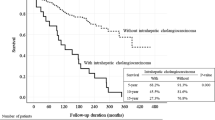Abstract
Background
Hepatolithiasis is a known risk factor for cholangiocarcinoma (CC). Due to the high risk of complications that accompany endoscopic and surgical stone removal, it is often difficult to decide whether it is beneficial to remove intrahepatic ductal stones. We conducted a case–control study to determine the risk of developing CC and the benefit of stone removal in patients with hepatolithiasis.
Methods
Twenty-three patients with CC group between 2002 and 2012 were included in this study. For each patient with CC, four control patients with hepatolithiasis were enrolled based on age and sex matching. Finally, 115 patients with hepatolithiasis were enrolled.
Results
The mean length of time that intrahepatic stones were present was 116.57 (±98.77) months in the CC group and 80.56 (±101.10) months in the control group. History of gastrectomy [OR 5.756 (1.329–24.930), p = 0.019], history of choledochoenterostomy (OR 4.938 [1.129–21.595], p = 0.034), serum CA19-9 level [OR 1.001 (1.000–1.001), p = 0.022], and complete removal of stones [OR 0.167 (0.052–0.539), p = 0.003] were independent predictive factors of CC. In patients who had undergone incomplete removal of stones, the occurrence of CC was significantly reduced overall as well as in a subgroup of patients with elevated CA19-9 (p = 0.015 and p = 0.006, respectively) compared to patients with a CA19-9 of <22 U/mL (p = 0.477).
Conclusions
History of gastrectomy or choledochoenterostomy, high levels of serum CA19-9, and incomplete removal of stones were potential predictive factors of CC in patients with hepatolithiasis. Additionally, complete removal of stones may reduce the risk of CC in patients with high serum CA19-9 levels (>22 U/mL).



Similar content being viewed by others

References
Tyson GL, El-Serag HB (2011) Risk factors for cholangiocarcinoma. Hepatology 54:173–184
Mori T, Sugiyama M, Atomi Y (2006) Gallstone disease: management of intrahepatic stones. Best Pract Res Clin Gastroenterol 20:1117–1137
Park YH, Park SJ, Jang JY, Ahn YJ, Park YC, Yoon YB, Kim SW (2004) Changing patterns of gallstone disease in Korea. World J Surg 28:206–210
Kim YT, Byun JS, Kim J, Jang YH, Lee WJ, Ryu JK, Kim SW, Woon YB, Kim CY (2003) Factors predicting concurrent cholangiocarcinomas associated with hepatolithiasis. Hepatogastroenterology 50:8–12
Liu ZY, Zhou YM, Shi LH, Yin ZF (2011) Risk factors of intrahepatic cholangiocarcinoma in patients with hepatolithiasis: a case–control study. Hepatobiliary Pancreat Dis Int 10:626–631
Suzuki Y, Mori T, Abe N, Sugiyama M, Atomi Y (2012) Predictive factors for cholangiocarcinoma associated with hepatolithiasis determined on the basis of Japanese multicenter study. Hepatol Res 42:166–170
Van Erpecum KJ (2011) Pathogenesis of cholesterol and pigment gallstones: an update. Clin Res Hepatol Gastroenterol 35:281–287
Vitek L, Carey MC (2012) New pathophysiological concepts underlying pathogenesis of pigment gallstones. Clin Res Hepatol Gastroenterol 36:122–129
Lee TY, Lee SS, Jung SW, Jeon SH, Yun SC, Oh HC, Kwon S, Lee SK, Seo DW, Kim MH, Duh DJ (2008) Hepatitis B virus infection and intrahepatic cholangiocarcinoma in Korea: a case–control study. Am J Gastroenterol 103:1716–1720
Song CH, Park HC, Youn C, Joo HX (1997) Clinical review of cholelithiasis after gastric resection in patients with stomach cancer. J Korean Surg Soc 52:559–565
Oh SJ, Choi WB, Song J, Hyung WJ, Choi SH, Noh SH (2009) Complications requiring reoperation after gastrectomy for gastric cancer: 17 years experience in a single institute. J Gastrointest Surg 13:239–245
Dixon JA, Morgan KA, Adams DB (2009) Management of common bile duct injury during partial gastrectomy. Am Surg 75:719–721
Mon NN, Kokuryo T, Hamaguchi M (2009) Inflammation and tumor progression: a lesson from TNF-alpha-dependent FAK signaling in cholangiocarcinoma. Methods Mol Biol 512:279–293
Li SQ, Liang LJ, Peng BG, Lai JM, Lu MD, Li DM (2006) Hepaticojejunostomy for hepatolithiasis: a critical appraisal. World J Gastroenterol 12:4170–4174
Ohta T, Nagakawa T, Ueda N, Nakamura T, Akiyama T, Ueno K, Miyazaki I (1991) Mucosal dysplasia of the liver and the intraductal variant of peripheral cholangiocarcinoma in hepatolithiasis. Cancer 68:2217–2223
Disclosures
Jung Hyun Jo, Moon Jae Chung, Jeong Youp Park, Seungmin Bang, Seung Woo Park, Kyung Sik Kim, Woo Jung Lee, Si Young Song, and Jae Bock Chung have no conflicts of interest or financial ties to disclose.
Author information
Authors and Affiliations
Corresponding author
Rights and permissions
About this article
Cite this article
Jo, J.H., Chung, M.J., Park, J.Y. et al. High serum CA19-9 levels are associated with an increased risk of cholangiocarcinoma in patients with intrahepatic duct stones: a case–control study. Surg Endosc 27, 4210–4216 (2013). https://doi.org/10.1007/s00464-013-3025-1
Received:
Accepted:
Published:
Issue Date:
DOI: https://doi.org/10.1007/s00464-013-3025-1



